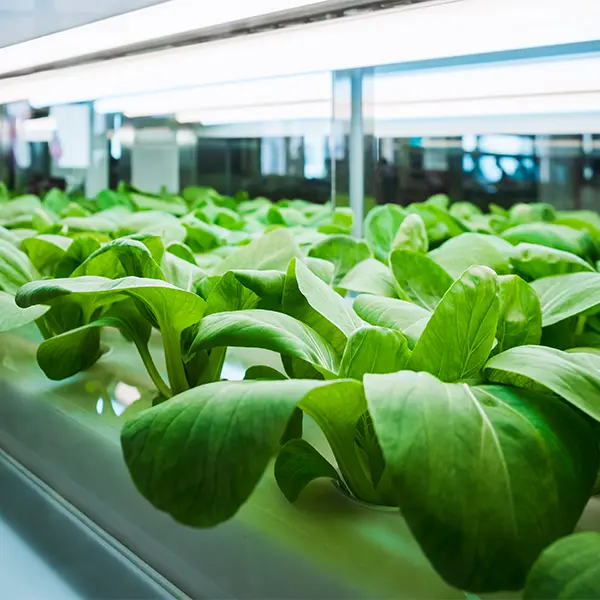Pentingnya Pengukur Cahaya dalam Pertanian Dalam Ruangan

Pertanian dalam ruangan telah mengubah cara kita membudidayakan tanaman, memungkinkan tanaman tumbuh subur di lingkungan terkendali yang terlindungi dari fluktuasi cuaca eksternal. Agar sistem ini berfungsi secara efektif, produsen dalam ruangan harus memantau dan mengatur faktor-faktor yang memengaruhi pertumbuhan tanaman dengan cermat, dengan cahaya sebagai salah satu elemen terpenting. Cahaya merupakan kekuatan pendorong di balik fotosintesis, proses yang dilakukan tanaman untuk mengubah cahaya menjadi energi.
Tepat pengukuran cahaya memastikan bahwa tanaman menerima intensitas cahaya, kualitas, dan durasi yang tepat yang diperlukan untuk fotosintesis, pertumbuhan, dan hasil panen yang sehat. Lampu buatan, seperti lampu LED, HPS (High-Pressure Sodium), dll., digunakan dalam pengaturan pertanian dalam ruangan untuk meniru sinar matahari. Namun, menyalakan lampu saja tidak cukup. Tanpa pengukuran cahaya yang tepat, produsen dalam ruangan berisiko menyediakan cahaya yang berlebihan, yang dapat menyebabkan stres panas dan kerusakan daun, atau cahaya yang tidak mencukupi, yang dapat menghambat pertumbuhan tanaman.
Memastikan Cahaya Optimal untuk Pertumbuhan Tanaman
Aspek terpenting dari cahaya untuk pertumbuhan tanaman adalah Radiasi Aktif Fotosintesis (PAR), yang mengacu pada rentang panjang gelombang cahaya antara 400 nm dan 700 nm yang digunakan tanaman untuk proses vital fotosintesis. Tidak seperti sinar matahari, yang menyediakan spektrum cahaya yang luas, sumber cahaya buatan dapat bervariasi secara signifikan dalam keluaran spektralnya, yang berarti beberapa mungkin memancarkan lebih banyak panjang gelombang tertentu daripada yang lain. Oleh karena itu, pengukuran cahaya yang akurat sangat penting bagi petani dalam ruangan, yang memungkinkan mereka untuk membuat penyesuaian yang tepat pada sistem pencahayaan mereka. Ini memastikan bahwa tanaman menerima PAR yang cukup untuk fotosintesis yang efektif, yang mendorong pertumbuhan yang sehat. Lebih jauh lagi, petani dalam ruangan dapat menilai bagaimana cahaya didistribusikan di seluruh ruang tumbuh, memastikan distribusi cahaya yang merata, yang sangat penting untuk mencegah area dengan paparan kurang atau paparan berlebihan yang dapat menghambat perkembangan tanaman.
Dua konsep pengukuran penting dalam pertanian dalam ruangan adalah PPFD (Photosynthetic Photon Flux Density) dan Daily Light Integral (DLI). PPFD merujuk pada jumlah cahaya, khususnya dalam rentang PAR, yang mencapai permukaan tanaman setiap detik. Hal ini dinyatakan dalam mikromoles per meter persegi per detik (µmol/m²/s), yang memberikan gambaran instan tentang seberapa banyak cahaya yang dapat digunakan untuk fotosintesis pada saat tertentu. Metrik ini penting untuk dipantau oleh petani, karena secara langsung memengaruhi kemampuan tanaman untuk berfotosintesis secara efisien. DLI, di sisi lain, mengukur jumlah total cahaya PAR yang diterima tanaman selama sehari penuh (24 jam). Hal ini dinyatakan dalam mol per meter persegi per hari (mol/m²/hari), dan mengumpulkan pembacaan PPFD sepanjang hari untuk memberikan nilai paparan cahaya secara keseluruhan. Metrik ini sangat penting karena tanaman bergantung pada total paparan cahaya untuk pertumbuhan dan perkembangan, bukan hanya intensitas cahaya sesaat. Setiap spesies tanaman memiliki persyaratan DLI yang berbeda, yang dapat bervariasi berdasarkan tahap pertumbuhan dan kondisi lingkungannya. Misalnya, tanaman buah seperti tomat biasanya memerlukan kadar DLI yang lebih tinggi dibandingkan dengan sayuran berdaun hijau untuk menghasilkan hasil panen yang optimal. Dengan memahami dan mengoptimalkan DLI, petani dalam ruangan dapat meningkatkan hasil panen secara signifikan, tidak hanya tetapi juga kesehatan dan vitalitas tanaman secara keseluruhan, yang mengarah pada operasi pertanian dalam ruangan yang lebih produktif dan sukses.
Solusi Pengukuran Cahaya Penginderaan Konica Minolta untuk Pertanian Dalam Ruangan

Konica Minolta Sensing, pemimpin dalam solusi pengukuran, menyediakan berbagai solusi pengukuran yang komprehensif alat pengukur cahaya penting bagi petani dalam ruangan yang membutuhkan pengukuran cahaya yang akurat dan dapat diandalkan. Spektrofotometer Iluminasi Konica Minolta CL-500A unggul dalam bidang ini, menawarkan kemampuan untuk mengukur iradiasi spektral dengan resolusi 1 nm pada panjang gelombang 360 hingga 780 nm. Hal ini memungkinkan perhitungan PPFD dan DLI yang akurat untuk memantau intensitas sesaat dan total cahaya harian yang diterima tanaman guna memastikan cahaya optimal untuk fotosintesis yang efektif.
Selain itu, beberapa unit Spektrofotometer Iluminasi CL-500A dapat dihubungkan menggunakan perangkat lunak manajemen data standar CL-S10w, memfasilitasi pengukuran multi-titik untuk menilai distribusi cahaya secara efektif guna memastikan bahwa semua area ruang tumbuh menerima tingkat cahaya yang cukup untuk pertumbuhan tanaman yang sehat.
Selain pengukuran cahaya, Konica Minolta Sensing menyediakan solusi pengukuran lain yang dirancang untuk membantu petani dalam ruangan mengoptimalkan proses produksi mereka. Misalnya, kamera pencitraan hiperspektral Specim FX Dan Specim IQ menawarkan wawasan komprehensif tentang indikator kesehatan tanaman seperti kandungan klorofil, deteksi penyakit, dan tingkat stres. Selain itu, instrumen pengukuran warna seperti Spektrofotometer CM-5 dan Pengukur Kroma CR-400 Dan CR-410 memungkinkan analisis dan pemantauan yang tepat terhadap warna dan kualitas produk. Jelajahi bagian solusi pengukuran pertanian dan pangan untuk menemukan rangkaian lengkap cahaya, warna, dan SPAD solusi pengukuran, termasuk solusi pencitraan hiperspektral, untuk industri pertanian dan makanan.
Butuh bantuan memilih alat pengukur cahaya atau solusi pengukuran yang sesuai untuk operasi pertanian dalam ruangan Anda? Hubungi kami untuk konsultasi gratis dengan tim ahli kami untuk memandu Anda dalam memilih alat yang tepat untuk kebutuhan Anda dan membantu Anda mengoptimalkan proses bertani dalam ruangan Anda.
